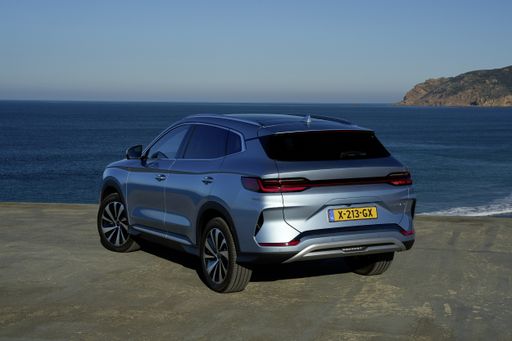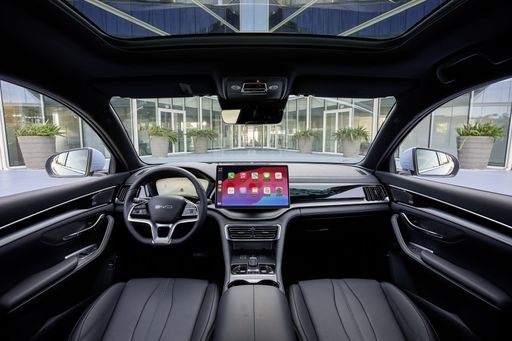The automotive market is rapidly evolving, particularly with the rise of electric and hybrid vehicles. In this comparison, we explore two standout models: the BYD Seal U and the GWM WEY 03. Both vehicles demonstrate significant advancements in technology, performance, and design, appealing to a growing consumer base interested in eco-friendly options.
BYD Seal U vs GWM WEY 03 – Which one offers the better deal?
Compare performance, boot capacity, efficiency and price at a glance.
Find out which car is the better choice for you – BYD Seal U or GWM WEY 03?
Powertrains and Performance
The BYD Seal U offers a choice between a plugin hybrid and an electric drivetrain, delivering a power range from 218 HP to an impressive 324 HP. The Seal U boasts a maximum torque of 330 Nm for the hybrid model and up to 550 Nm for the electric version, illustrating its robust performance across various terrains. With a 0-100 km/h acceleration time as low as 5.9 seconds, the Seal U is designed for those who enjoy spirited driving.
In contrast, the GWM WEY 03 focuses on a plugin hybrid setup that can produce up to 442 HP. This model features a remarkable torque output of 685 Nm, allowing the vehicle to dash from 0 to 100 km/h in just 5.3 seconds. With such high power ratings, the WEY 03 not only matches but can outperform many conventional SUVs in its class.
Consumption and Efficiency
When it comes to fuel efficiency, the BYD Seal U stands out with a consumption rating of just 0.9 L/100km for its hybrid variant. Meanwhile, the electric version has an electric consumption of 19.9 kWh/100km, allowing for a substantial electric range of around 420 km. The Seal U has a CO2 emission rating between 0 g/km to a maximum of 26 g/km, depending on the model configuration.
The GWM WEY 03 also showcases impressive efficiency figures, with a consumption of only 0.5 L/100km and an electric range of up to 139 km. This model releases just 15 g/km of CO2, ensuring it aligns with modern environmental standards. Overall, both vehicles demonstrate a commitment to reducing their ecological footprint.
Dimensions and Space
For those requiring ample space, the GWM WEY 03 presents a generous trunk capacity of 517 liters and a height of 1730 mm, providing roominess and comfort for passengers and cargo alike. The WEY 03 measures 4688 mm in length and 1890 mm in width, making it a compact SUV that does not compromise on space.
By comparison, the BYD Seal U is slightly longer at 4775 mm and shares the same width of 1890 mm. With a trunk capacity of 425 to 552 liters depending on the configuration, it offers adaptable space, catering to various storage needs.
Innovations and Features
The BYD Seal U incorporates cutting-edge technology such as advanced driver-assistance systems (ADAS) and a digital cockpit designed for seamless connectivity. Its multiple driving modes, including an all-wheel-drive option, ensure versatility across diverse driving conditions.
On the other hand, the GWM WEY 03 excels with features like an intuitive infotainment system, offering enhanced connectivity options and smart navigation functionalities. The innovative DCT automatic transmission provides smooth gear transitions that enhance the overall driving experience.
Conclusion
Choosing between the BYD Seal U and the GWM WEY 03 ultimately depends on individual preferences and priorities. The BYD Seal U excels in a balanced offering of eco-friendliness and practical performance while providing superb efficiency figures. Meanwhile, the GWM WEY 03 appeals to those seeking exhilarating performance coupled with hybrid technology. Both models exhibit advancements in innovation and design, showcasing the promising direction of the automotive industry.
Here’s where it gets real: The technical differences in detail
Costs and Efficiency:
Price and efficiency are often the first things buyers look at. Here it becomes clear which model has the long-term edge – whether at the pump, the plug, or in purchase price.
BYD Seal U has a to a small extent advantage in terms of price – it starts at 34300 £, while the GWM WEY 03 costs 41100 £. That’s a price difference of around 6780 £.
Fuel consumption also shows a difference: BYD Seal U manages with 0.40 L and is therefore clearly perceptible more efficient than the GWM WEY 03 with 0.50 L. The difference is about 0.10 L per 100 km.
As for range, the BYD Seal U performs decisively better – achieving up to 500 km, about 361 km more than the GWM WEY 03.
Engine and Performance:
Power, torque and acceleration say a lot about how a car feels on the road. This is where you see which model delivers more driving dynamics.
When it comes to engine power, the GWM WEY 03 has a distinct edge – offering 442 HP compared to 324 HP. That’s roughly 118 HP more horsepower.
In acceleration from 0 to 100 km/h, the GWM WEY 03 is to a small extent quicker – completing the sprint in 5.30 s, while the BYD Seal U takes 5.90 s. That’s about 0.60 s faster.
In terms of top speed, the GWM WEY 03 performs distinct better – reaching 230 km/h, while the BYD Seal U tops out at 180 km/h. The difference is around 50 km/h.
There’s also a difference in torque: GWM WEY 03 pulls a bit stronger with 685 Nm compared to 550 Nm. That’s about 135 Nm difference.
Space and Everyday Use:
Whether family car or daily driver – which one offers more room, flexibility and comfort?
Both vehicles offer seating for 5 people.
In curb weight, BYD Seal U is somewhat lighter – 1940 kg compared to 2175 kg. The difference is around 235 kg.
In terms of boot space, the BYD Seal U offers slight more room – 552 L compared to 517 L. That’s a difference of about 35 L.
In maximum load capacity, the BYD Seal U performs somewhat better – up to 1465 L, which is about 176 L more than the GWM WEY 03.
When it comes to payload, BYD Seal U minimal takes the win – 410 kg compared to 375 kg. That’s a difference of about 35 kg.
Who comes out on top?
Overall, the BYD Seal U shows itself to be shows small but notable strengths and secures the title of DriveDuel Champion.
It convinces with the more balanced overall package and proves to be the more versatile choice for everyday use.
 @ BYD Auto / BYD Global Media
@ BYD Auto / BYD Global Media
BYD Seal U
BYD Seal U
The BYD Seal U pairs a sleek fastback silhouette with a surprisingly roomy, tech-rich cabin, giving electric chic without the showroom pretension. It's a smart pick for buyers after confident handling, sensible practicality and standout value — all wrapped up with a cheeky grin when you put your foot down.
details @ BYD Auto / BYD Global Media
@ BYD Auto / BYD Global Media
 @ BYD Auto / BYD Global Media
@ BYD Auto / BYD Global Media
 @ BYD Auto / BYD Global Media
@ BYD Auto / BYD Global Media
GWM WEY 03
The GWM WEY 03 offers a sleek and modern design that captures attention on the road. Its interior is crafted with premium materials, providing a comfortable and luxurious driving experience. Advanced technology features enhance both safety and convenience, making it a compelling choice for the discerning driver.
details
 @ BYD Auto / BYD Global Media
@ BYD Auto / BYD Global Media
|
|
|
|
|
Costs and Consumption |
|
|---|---|
|
Price
34300 - 39800 £
|
Price
41100 - 47900 £
|
|
Consumption L/100km
0.4 - 1.2 L
|
Consumption L/100km
0.50 L
|
|
Consumption kWh/100km
19.9 - 20.5 kWh
|
Consumption kWh/100km
-
|
|
Electric Range
70 - 500 km
|
Electric Range
130 - 139 km
|
|
Battery Capacity
-
|
Battery Capacity
28.90 kWh
|
|
co2
0 - 26 g/km
|
co2
15 g/km
|
|
Fuel tank capacity
60 L
|
Fuel tank capacity
55 L
|
Dimensions and Body |
|
|---|---|
|
Body Type
SUV
|
Body Type
SUV
|
|
Seats
5
|
Seats
5
|
|
Doors
5
|
Doors
5
|
|
Curb weight
1940 - 2147 kg
|
Curb weight
2175 - 2295 kg
|
|
Trunk capacity
425 - 552 L
|
Trunk capacity
517 L
|
|
Length
4775 - 4785 mm
|
Length
4688 mm
|
|
Width
1890 mm
|
Width
1890 mm
|
|
Height
1668 - 1670 mm
|
Height
1730 mm
|
|
Max trunk capacity
1440 - 1465 L
|
Max trunk capacity
1289 L
|
|
Payload
410 kg
|
Payload
375 kg
|
Engine and Performance |
|
|---|---|
|
Engine Type
Plugin Hybrid, Electric
|
Engine Type
Plugin Hybrid
|
|
Transmission
Automatic
|
Transmission
Automatic
|
|
Transmission Detail
CVT, Reduction Gearbox
|
Transmission Detail
Dual-Clutch Automatic
|
|
Drive Type
Front-Wheel Drive, All-Wheel Drive
|
Drive Type
All-Wheel Drive, Front-Wheel Drive
|
|
Power HP
218 - 324 HP
|
Power HP
367 - 442 HP
|
|
Acceleration 0-100km/h
5.9 - 9.6 s
|
Acceleration 0-100km/h
5.3 - 7.3 s
|
|
Max Speed
170 - 180 km/h
|
Max Speed
230 km/h
|
|
Torque
300 - 550 Nm
|
Torque
500 - 685 Nm
|
|
Number of Cylinders
4
|
Number of Cylinders
4
|
|
Power kW
160 - 238 kW
|
Power kW
270 - 325 kW
|
|
Engine capacity
1497 - 1498 cm3
|
Engine capacity
1998 cm3
|
General |
|
|---|---|
|
Model Year
2024
|
Model Year
2024
|
|
CO2 Efficiency Class
B, A
|
CO2 Efficiency Class
B
|
|
Brand
BYD
|
Brand
GWM
|
What drive types are available for the BYD Seal U?
The BYD Seal U is available as Front-Wheel Drive or All-Wheel Drive.
The prices and data displayed are estimates based on German list prices and may vary by country. This information is not legally binding.
